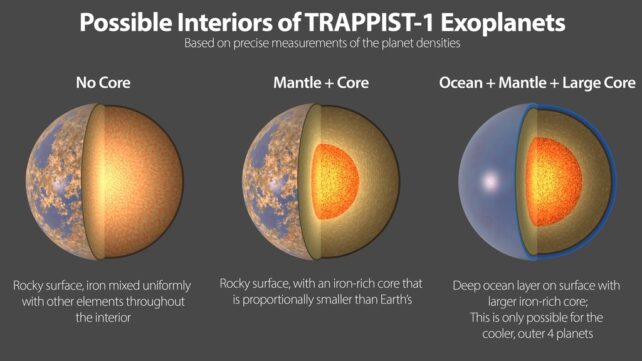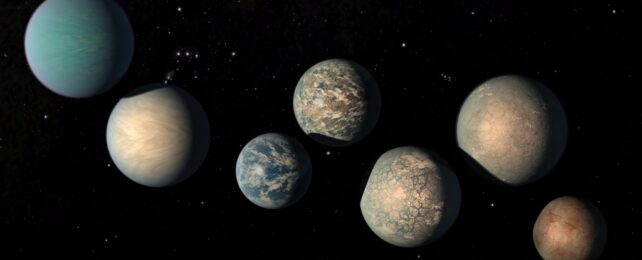A seven-planet system some 40 light-years from Earth could be swimming in water, new research shows.
In February 2017 scientists announced the discovery of several exoplanets orbiting the red dwarf star TRAPPIST-1, and ever since astronomers have keenly monitored the system for potential signs of life (aka biosignatures).
According to recent findings, these planets may have an abundance of one of the most crucial elements for life: water.
Since the discovery, scientists have gone back and forth on whether any planets in the TRAPPIST-1 system could be habitable. Much like the Proxima Centauri system and its Earth-like planet (Proxima b), the debate has centered on their parent stars: M-type (red dwarf) stars. These stars are smaller and cooler than our Sun and are noted for the way they are prone to flare activity.
Another major question is the availability of water in this system. Previous findings have indicated that planets orbiting red dwarfs may have an overabundance of water, but they may not hold onto it for long.
These findings are supported by other research that has revealed that these planets experience high rates of water lost to space, caused by the intense ultraviolet (UV) radiation from their host star.
In a new study, a team of researchers led by astrobiologist Trent Thomas from the University of Washington addressed recent findings by the JWST.

Recent observations by JWST of TRAPPIST-1 c ruled out a thick carbon dioxide atmosphere, indicating that the planet is not as "Venus-like" as previously thought. However, these observations did not rule out the presence of water vapor or oxygen produced by its chemical dissociation.
As the team explained in their paper, "the maintenance of atmospheric water vapor would require a present-day water source, such as volcanic outgassing."
To investigate this possibility and estimate plausible outgassing rates on the TRAPPIST-1 planets, the team developed a theoretical outgassing model based on the rocky planets of the Solar System ( Mercury, Venus, Earth, and Mars). They then applied filters based on observations of the system and what is known about its geochemistry to constrain plausible scenarios.
Their findings indicated that the outgassing rates of all seven planets would be between 0.03 and eight times that of Earth. However, they also found that magma emplacement rates (the speed at which magma moves through a planet) were similar to those of Mars.
While there are indications that Mars still has magma beneath its surface, it is considered 'volcanically dead'. The same may be true of the TRAPPIST-1 planets.
"Our model results for magma emplacement rates also indicate that the TRAPPIST-1 planets are currently more likely to have low-to-no volcanic activity," the researchers write in their paper.
"Our results indicate that the water outgassing rates on the TRAPPIST-1 planets are more likely to be lower than Earth's, but the plausible range also includes outgassing rates that are an order of magnitude higher than Earth's."
Their results further indicated that the TRAPPIST-1 planets may have relatively dry Earth-like mantles. But as they emphasized, it is possible that water could make up to 1 percent of their mass fractions.
"Our results indicate that drier mantles are preferred within the broader explored range of mantle water content," the team explains.
"This arises due to our assumption that the TRAPPIST-1 planets have terrestrial interiors with mantle water contents that remain below 1 percent by weight upper limit throughout the 5.4 billion-year age of the TRAPPIST-1 system. The preference for lower mantle H2O values is more consistent with Earth's mantle water content."
This is especially interesting considering that while water covers about 71 percent of Earth's surface, it constitutes only about 0.02 percent of its total mass.
This could mean that planets orbiting within TRAPPIST-1's habitable zone are volcanically inactive and have varying degrees of water, ranging from potential 'water worlds' and barren rocky worlds to Earth-like planets covered in oceans.
These results reinforce the idea that the TRAPPIST-1 system has no shortage of water. Unfortunately, many questions remain about its habitability.
Fortunately, Webb's observations of TRAPPIST-1 (and other red dwarf systems) are still in their infancy. Additional observations will allow astronomers to constrain the potential habitability of this system.
Their findings were reported in a preprint available on arXiv.
